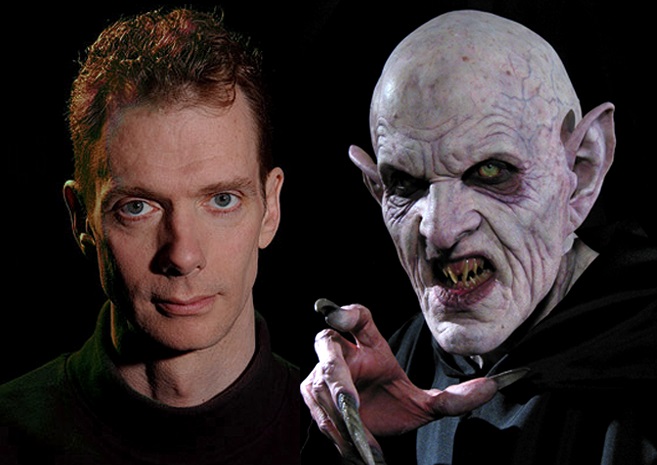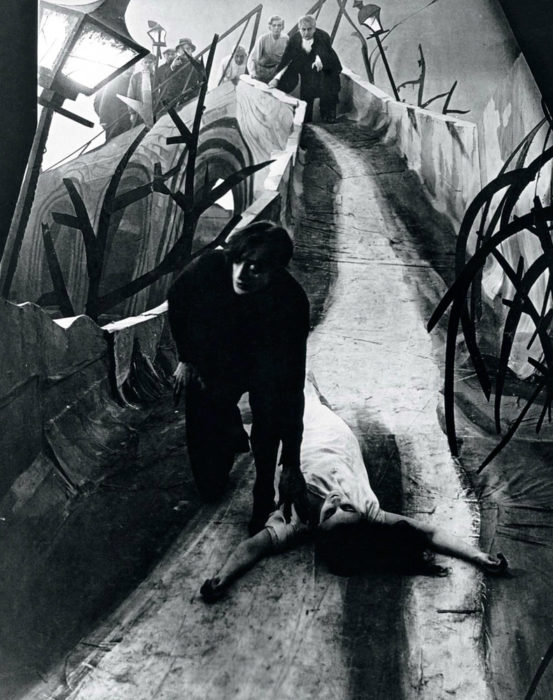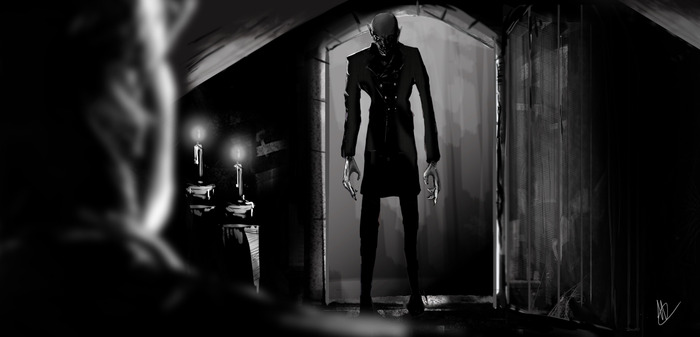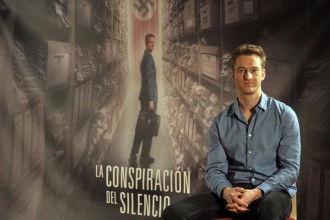David Lee Fisher es un joven director/productor que, en 2005, rodó un remake del clásico silente ‘El gabinete del Dr. Caligari’ (película que se puede ver gratuitamente aquí http://youtu.be/zOQ_T6T0PT8). Entonces, decidió llamar a su versión un «remix», ya que reutilizaba muchos elementos visuales del original y ponía a nuevos actores allí, de una forma no demasiado distinta a hacer el remix de una canción.
Su próximo proyecto (o «remix») es otra película de terror clásica de los años 20: ‘Nosferatu, una sinfonía del horror’. El personaje del título será interpretado por el actor de culto Doug Jones, que ya ha aparecido en otros roles monstruosos en las películas ‘El laberinto del fauno’ y ‘Hellboy’.
En esta pequeña entrevista, el director habla de sus intenciones con la nueva película y el origen del proyecto:
• Tanto el original de 1922 como el remake de 1979 carecen, curiosamente, de sangre. Esto significa que mi primera pregunta es obligada: ¿habrá algo de «gore» en esta ocasión?
R: ¡Sí! Aunque yo no diría que demasiado. Creo que enseñar, al menos, un poco de sangre, es necesario para entender su importancia dentro de los temas de la historia. Orlok, para mí, es una metáfora… esa fuerza universal que nos «quita», mientras que Ellen es aquello que «da». Como se dice en ‘Drácula’, la sangre es la vida, de forma que enseñarlo hace todo este significado mucho más literal.
• ¿Como de cercana es esta versión a la de Murnau? ¿Se trata de un remake plano a plano o más bien una actualización completa del mito?
R: Nuestra versión es muy cercana a la original, pero, definitivamente, no se trata de un remake plano a plano. La original ya existe de forma que la pregunta que debemos plantearnos es, ¿como podemos aportar algo nuevo, mientras respetamos la visión del equipo original? Además, uno de nuestros objetivos siempre ha sido el de introducir a un público totalmente nuevo a estas maravillosas películas, así que trabajamos cuidadosamente en mantener el espíritu del original, mientras actualizamos ciertos elementos de la historia, el diálogo o los valores visuales, para una audiencia moderna.
• Al contrario que Herzog, has decidido mantener los nombres originales (tu monstruo se llama Orlock en lugar de Drácula). Para mi, esta es la opción correcta, pero me gustaría conocer tu opinión y el por qué de esta decisión.
R: Sí, mantenemos los nombres originales. Para mí, más allá de ser vampiros, no hay muchos parecidos entre Orlok y Drácula. Las intenciones de Orlok son muy básicas, simples. Es, igual que en la película original, la metáfora de una Venus atrapamoscas. Es parte del mundo natural y, sencillamente, «hace lo que hace». Como un terremoto o un tornado; no una fuerza necesariamente maligna pero sí destructiva. En este caso concreto, Orlok se siente atraído hacia Ellen, pero sólo como las luces atraen a las polillas a su destrucción. Drácula, sin embargo, es calculador, astuto, un estratega. Mucho más «humano» y no un monstruo elemental. Además, Orlok suena como Warlock (brujo en inglés) y eso mola bastante.
• La película original tiene un final muy poderoso que, a pesar de su valor trágico, muestra una clara victoria de la luz sobre la oscuridad. Herzog, sin embargo, nos dice que el mal siempre gana. Este tipo de cosas pueden definir el tono de toda la película así que, sin destriparnos la película, ¿Con qué filosofía te sientes más dientificado?
R: Nuestro final es más una revelación, en el sentido de que muestra las consecuencias de las acciones de Hutter, nuestro protagonista… o mejor dicho, la carencia de estas. Sin contar demasiado, la verdad es que, hasta ese momento, no parece tener mucha idea de lo que ocurre a su alrededor!
• Sobre la música, ¿será totalmente nueva o basada en el trabajo de Hans Erdmann?
R: Totalmente nueva, compuesta por Eban Schletter que hizo un trabajo magnífico en ‘The Cabinet of Dr. Caligari’. Ahora mismo está escribiendo dos partituras distintas: una de ellas es independiente, una especie de «Requiem» y, de ahí, saldrán los temas de la banda sonora. Ha sido él quien ha decidido componer la música de esta forma y a mí, personalmente, me parece una idea increíble y muy original.
• ¿La película será tintada, totalmente a color o en blanco y negro?
R: ¡Buena pregunta! Ahora mismo, estamos probando un método de colorización que homenajea a los métodos de tintado. De forma que, es un híbrido entre una película a color y una tintada. Puesto que la original siempre se pensó para ser proyectada con planos tintados, pensé que esta sería una buena oportunidad para jugar con la idea.
• A pesar de la creencia general, muchos académicos no consideran ‘Nosferatu’ parte del «expresionismo alemán». Murnau deseaba crear una fantasía realista, rodando en exteriores y animando a sus actores a trabajar de forma más natural. Mi pregunta es, ¿vais a desviaros de este estilo? ¿Buscáis algo más onírico o incluso expresionista? ¿Cuanta pantalla verde vais a usar?
R: Estoy de acuerdo con que ‘Nosferatu’ es una película de «estilo», pero no verdaderamente expresionista, o al menos no como lo es «Caligari». Pero el expresionismo en la película es una característica fundamental de su personaje, está integrado en el propio argumento. Al igual que «Caligari», ‘Nosferatu’ es una historia muy simple que, sin embargo, tiene unos importantes cimientos de subtexto. Nuestra versión necesita elementos ciertamente expresionistas para poder contar la historia de una forma profunda y significativa, así que añadiré cuanto pueda. En términos de pantallas verdes… todavía hay que decidirlo. Creo que usaremos más de lo que uno pensaría para una película así. Además, me gustaría poder crear elementos nuevos basados en la imaginería del original, así como una iluminación dramática y efectos climáticos imposibles.
• ¿Cual es tu opinión de la película del año 2000 ‘La sombra del vampiro’?
R: Malkovich y Dafoe… ¡que más puedo decir! Lo que más me gustó de la película, era la idea de mostrar la realidad de un rodaje en aquella época, mientras nos mostraba esa versión totalmente fantástica de Schreck. ¡Era bastante guay!
• También me gustaría saber tu opinión acerca de la adaptación más reciente (y para muchos, la mejor) del clásico de Bram Stoker: el Drácula de Francis Ford Coppola.
R: Creo que habré visto la versión de Coppola como un millón de veces. Solía tenerla puesta de fondo mientras trabajaba. Cuando salió el Blu-Ray, me quedé impresionado con los extras, sobre todo esa escena en la que Coppola y Oldman discuten sobre como Gary debía entrar en escena con la linterna. Me encanta como muestran la realidad del arte de hacer películas. Una vez conocí a Gary Oldman, cuando estaba en una tienda Staples en Hollywood. Le mencioné que había visto su armadura roja en la bodega de Coppola en winery in Napa. Él me dijo que no tenía ni idea de donde estaba eso. La verdad es que fué una persona generosa y simpática y tuvimos una charla bastante agradable.
• Después de Caligari y Nosferatu, ¿que otros clásicos del cine mudo crees que merecerían un remake (o «remix»)?
R: Hay una, que es algo así como el bisabuelo de todas, que me encataría poder revisar, aunque aquello sería una auténtica aventura, si sabes a lo que me refiero (evidentemente, habla de ‘Ladrón de Bagdad’) También me gustaría probar con ‘Der Golum’ y, por supuesto, el ‘Fausto’ de Murnau.
• Mi última pregunta es, que opinas de los orígenes «ocultistas» de Nosferatu y Prana films? Tienes algún interés en la magia o consideras todo eso chorradas sin sentido?
R: A lo largo de los años, he conseguido muchos libros sobre este tema y, realmente, lo encuentro fascinante. Siempre me di cuenta de que el contrato que Knock escribe para Orlok está lleno de símbolos herméticos y alquimistas. Esto es algo que estará en la nueva película. También pienso que la historia de Albin Grau y Prana films es muy interesante.
Desde aquí, quiero dar las gracias al señor Fisher y a todo su equipo.
Si os apetece vosotros los lectores también podéis ayudar a financiar el proyecto. La página de kickstarter es esta: https://www.kickstarter.com/projects/82215933/nosferatu-the-feature-film-remix
Y eso es todo por ahora… ¡¡tened cuidado con los hijos de la noche!!
—————
La entrevista original fue realizada en inglés, por lo que hemos creído conveniente e interesante introducirla también:
David Lee Fisher is a young producer/director that, in 2005 filmed a remake of the silent classic «The gabinet of Dr. Caligari» (a movie that you can see here http://youtu.be/zOQ_T6T0PT8). That time, he called the film a «remix» because he actually reused a lot of visual elements of the original and put new actors there, in a way not very different of remixing a song.
His next project (or «remix») is another classic horror movie from the 20s: Nosferatu, a symphony of horror. The title character will be played by fan-favorite Doug Jones, that have been already in other make-up heavy roles in the films «Pan’s labyrinth» and «Hellboy».
In this little interview, the director talks about his intentions with the new movie and the inception of the entire project:
• Both the 1922 original and the 1979 remake have, oddly enough, no blood at all. This means the first question is mandatory: Is it going to be a little of gore this time?
A: Yes! But definately not overly «gory.» I think that showing at least some blood embodies the significance of its meaning to the story. Orlok, to me, is more of a metaphor – the universal force of «taking» whereas Ellen is «giving.» As in Dracula, the blood is the life, so to show it is to see its literal meaning.
• How close will your version be to Murnau original? Is it some short of shot-by-shot remake, or a full update of the myth?
A: Very close, but definitely not shot-by-shot. The original has already been done, so the question we always ask ourselves is what can we bring that’s new while still staying true the original’s vision? Also, one of our goals has always been to introduce these amazing films to new audiences as well, so it’s always a careful line to maintain the spirit of the original, while enhancing elements like story, dialog and visuals for a modern audience.
• Unlike Herzog, you are keeping the original names (your monster is called Orlock and not Dracula). For me, that’s the right thing to do, but I would like to know your own opinion on the subject and why you took that decision.
A: Yes, we are keeping the original names. And for me, besides both being vampires, Orlok actually shares very little with Dracula. Orlok’s intentions seem very base, simple, as in the original film’s metaphor of the Venus Fly trap. He’s just part of nature and «does what he does.» Like an earthquake or tornado; they’re not necessarily evil – they just are. Even if their results are totally destructive. In this case he’s attracted to Ellen’s «light» like a moth. Dracula is much more calculating, thoughtful and strategic. More human and less of an elemental monster. Besides, Orlok is like Warlock without the «W, » and I think that’s cool.
• The original movie has a very special ending that, despite its tragic value, represents a victory of the light over the darkness. Herzog, in the other hand, makes clear that evil always win. That kind of things can define the tone of the entire movie so, without giving away spoilers, with which philosophy do you most identify?
A: The new ending is more of a highlight regarding the consequences of the main character, Hutter’s, actions – or lack thereof. Without spoilers, he sure seems to be a little oblivious of what’s really going on around him!
• About the score, will it be brand new or based in the work of Hans Erdmann?
A: It’s a brand new score by composer Eban Schletter who did an amazing job on The Cabinet of Dr. Caligari. He’s actually writing two separate pieces for the film; a stand alone black mass or «Requiem,» and then the actual score for the film based on that. He was committed into delving into the film’s music this way, and I think its a really unique, amazing idea.
• Is the movie going to be tinted, fully colorized or black and white?
A: Ah, this is a good question. Currently we’re testing a way of doing colorization that also pay’s homage to tinting. So in way, it kind of a hybrid of color and tint. I felt because the original was meant to be tinted, it was a great opportunity to play with that idea.
• Despite the popular belief, many scholars don’t consider the original Nosferatu part of the «german expressionism» movement. Murnau tried to create a very naturalistic fantasy, filming mostly on location and encouraging a more realistic style of acting. My question is, are you going to make a departure from this style? Are you aiming for something more dream-like or even expressionist? How much green screen will have the final film?
A: I tend to agree that the original Nosferatu is more technically a German style film than true expressionism – Caligari being a good example of German expressionism’s truest form. But expressionism in film is almost its own character; it’s «baked into» the story. Since Nosferatu, like Caligari, is more or less a simple story riding on a large foundation of subtext, I think our new version needs expressionistic elements to tell the story in a deeply meaningful way, so I’m going to add a lot of it. In terms of green screen, it’s still to be seen, but I think we’ll use quite a bit more than one might think. Although I really want to create many brand new elements based on the original’s imagery and also add time-of-day and dramatic weather effects, too!
• What is your opinion on the 2000 movie «Shadow of the vampire»?
A: Malkovich and Dafoe, what can I say! What I liked about the movie was having the realistic insight into what it was like to actually direct and shoot a movie in that period, played against this kind of whimsical, fictional Shrek. It was cool!
• Also, I would like to know your opinion on the most modern big budget adaptation of Bram Stoker’s novel and, for many, the best one: Coppola’s Dracula.
A: I’ve probably watched Coppola’s version a thousand times. I used to let it play in the background while I worked for days on end. When the Blu-Ray came out, I was enthralled with the special features; especially the small scene where Coppola and Oldman are arguing about how Gary should enter with the lantern. I loved how that showed the realness of behind-the-scenes filmmaking. I actually met Gary Oldman once standing in line at the Staples office supply store in Hollywood! I mentioned I had seen his red armor from the film’s opening on display at Coppola’s winery in Napa, Ca. He replied he wondered where that was?! He was extremely kind and generous and we had a great talk.
• After making Caligari and Nosferatu, what other silent classics you consider are up for a remake (or «remix»)?
A: Well there’s one grand-daddy of all that I’d love to revisit, but it would definitely be an adventure to make (and I’m sure you can probably figure that one out!) Other than that I really love Der Golum and of course Murnau’s Faust.
• A last question I have is, what do you think about the «occult» origin of Nosferatu and Prana films? Do you have any interest in magic or do you consider all that stuff just silly nonsense?
R: I have collected a lot of books on the subject over the years and find them fascinating. I’ve always noticed Orlok’s contract to Knock is filled with hermetic and alchemy symbolism. Something that will also be revisited in the new film. I think the story of Albin Grau and Prana films is also a very interesting one.
A big thank you to Mr. Fisher and his entire team!
You can help, if you want, in the financing of this fascinating project. The kickstarter page is here: https://www.kickstarter.com/projects/82215933/nosferatu-the-feature-film-remix
And that’s all for now… beware the children of the night!!







